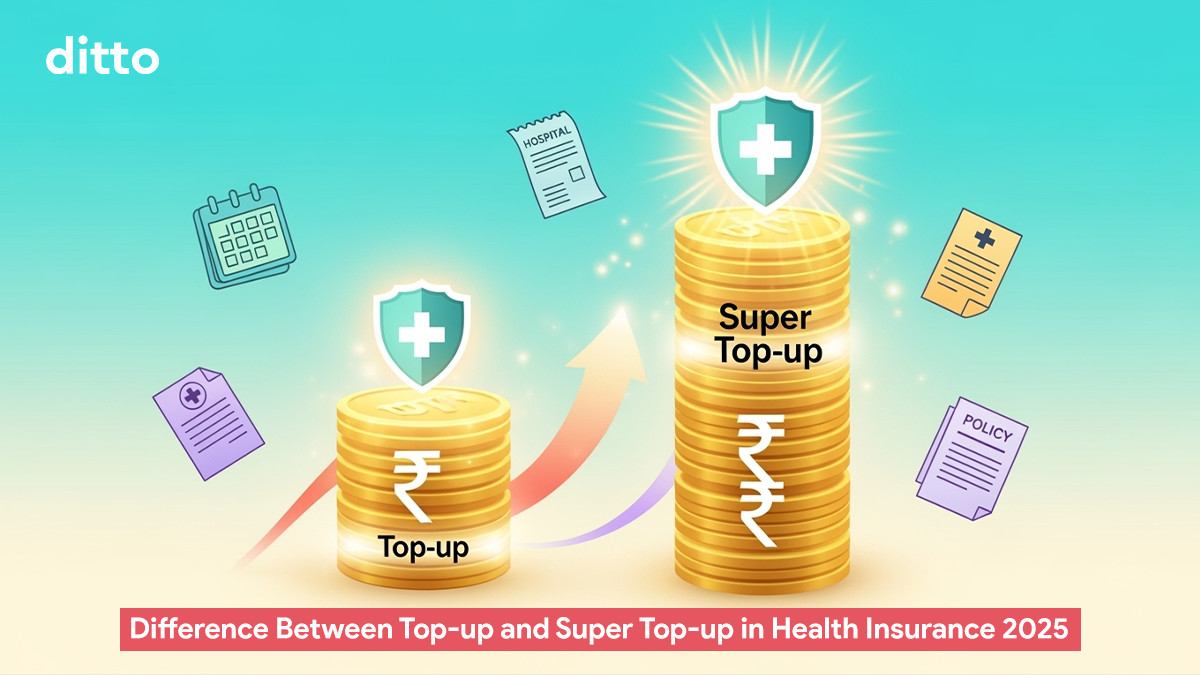| What is the difference between top-up and super top-up health insurance plans? Top-up and super top-up health insurance plans both provide additional coverage once medical expenses exceed a set deductible, but they differ in how this deductible is applied. A top-up plan starts working if one medical claim is higher than the deductible. A super top-up plan, on the other hand, adds up all your medical bills in a year and starts covering costs once the total crosses the deductible. |
Have you ever thought about enhancing your health insurance coverage without significantly increasing your premiums? At Ditto, we’ve spoken to thousands of customers who faced a similar dilemma after realizing that their base health insurance policies might not be enough to cover hospitalization expenses.
Top-up and super top-up in health insurance can prevent this by providing you with extra coverage once your medical expenses cross a specific limit. In this article, we will introduce you to both plans, explore their features, and delve into specific limitations to help you make the right choice.
If you still need help, feel free to contact our IRDAI-certified advisors to find the best health insurance plan for you.
What is Top-up in Health Insurance?
A top-up in health insurance is a supplemental policy that provides extra coverage once a single hospital bill or claim exceeds a pre-decided limit set by the insurer.
Suppose a policyholder’s base sum insured is exhausted during a large medical expense. In that case, the top-up plan pays the additional amount above the deductible (the amount you must pay or your base policy covers before the top-up plan kicks in).
However, the deductible applies to each claim separately, so the top-up plan only activates when one bill crosses this threshold. This makes it a cost-effective way to increase coverage without raising the base policy premium. New India Top-up Mediclaim and SBI Arogya are some common top-up plans in India.
These plans are a fair choice for those who already have a base policy or corporate health insurance but want extra protection for high-cost treatments. It's especially useful for covering surgeries, serious illnesses, or prolonged hospitalizations where expenses could wipe out your savings.
Ditto’s Take: Due to the limitations around deductibles in top-up plans, we generally do not recommend them. With the rise of more flexible and user-friendly super top-up plans, most insurers have discontinued traditional top-ups, leading to a steady decline in their popularity.
How Does a Top-Up Plan Work?
As mentioned earlier, a top-up plan only kicks in when a single hospitalization bill crosses the deductible. Each claim is checked separately. So let’s consider a scenario where the base policy is ₹3 lakh, the top-up amount is ₹7 lakh, and the deductible is ₹3 lakh.
Case 1: Claim of ₹2.5 lakh
This is below deductible so the bill is entirely paid from base policy.
Hence, top-up is not triggered.
Case 2: Claim of ₹5 lakh
Deductible = ₹3 lakh.
Insurer pays: ₹5 lakh – ₹3 lakh = ₹2 lakh (from the top-up).
The base policy with a coverage of ₹3 lakh will settle the initial medical expenses, and the top-up policy will then cover any amount beyond this limit.
Case 3: Two claims of ₹2.5 lakh each (in the same year)
Claim 1: ₹2.5 lakh (below deductible → paid by base policy).
Claim 2: ₹2.5 lakh (below deductible → paid by base policy/out of pocket).
Even though the total amount is ₹5 lakh, which is greater than the deductible, the top-up doesn’t pay because each claim is checked separately.
| Ditto’s Advice: Match your top-up deductible with your employer or base policy limit for full coverage. Put simply, you must choose a higher deductible only if your base plan reliably covers it. Conversely, a super top-up can offer better value for multiple smaller claims. |
What is a Super Top-up in Health Insurance?
A super top-up in health insurance is a supplementary policy that provides additional coverage when the total of multiple hospital bills in a policy year exceeds a set deductible. Unlike a regular top-up, which only responds if a single claim crosses the deductible, a super top-up plan considers the aggregate of all claims in a year.
This means once cumulative medical expenses surpass the deductible, the super top-up pays for all further costs up to the sum insured. It’s highly useful for people who face repeated hospitalizations or high annual medical expenses. Care Supreme Enhance and ICICI Activate Booster are some common super top-up plans in India.
At Ditto, we rarely recommend super top-up plans for those who already have robust base health insurance coverage. But they can be helpful in certain cases, especially when you:
- Depend on a basic employer-provided health plan
- Want a more cost-effective way to boost your total coverage
- Expect high or recurring medical costs
How Does a Super Top-Up Plan Work?
A super top-up plan considers cumulative claims in a policy year. Once your total bills exceed the deductible, the plan pays the excess amount. Let's consider another scenario here where the base policy is ₹3 lakh, the super top-up is ₹7 lakh, and the deductible is ₹3 lakh.
Case 1: Claim of ₹2.5 lakh
Cumulative Expenses = ₹2.5 lakh (below deductible).
Entirely paid by the base policy.
Case 2: Next Claim of ₹2.5 lakh
Cumulative Expenses = ₹5 lakh.
Deductible = ₹3 lakh.
Super Top-up pays: ₹5 lakh – ₹3 lakh = ₹2 lakh (since 50K was paid from the base plan).
Case 3: Another Claim of ₹4 lakh
Cumulative Expenses = ₹9 lakh.
Deductible = ₹3 lakh.
Already covered: ₹5 lakh (from earlier claims).
The insurer will pay an additional ₹4 lakh entirely through the Super Top-Up policy, as the deductible limit has already been exceeded.
Premium Comparison of Popular Super Top-up Plans
| Before we discuss the list, here’s how we decide what plans to feature. At Ditto, every health plan goes through our six-point evaluation framework. It doesn’t mean these are the only good plans, but that they stand out after being scored across all six pillars. You can learn more about how we evaluate health insurance plans here. |
| Age (in years)/Profile | Care Supreme Enhance | Aditya Birla Super Health Plus (B) | ICICI Activate Booster |
| 25 - Individual | ₹ 2,238 | ₹ 2,317 | ₹ 1,751 |
| 30, 32 - Couple, Floater | ₹ 2,663 | ₹ 3,584 | ₹ 2,629 |
| 36, 34, 4 - Family, Floater | ₹ 3,503 | ₹ 5,551 | ₹ 4,071 |
| 41,40, 8, 3 - Family, Floater | ₹ 4,439 | ₹ 6,852 | ₹ 5,391 |
| 62, 61 - Senior Couple, Floater | ₹ 12,414 | ₹ 23,506 | ₹ 11,573 |
*These illustrative premiums are for healthy profiles living in New Delhi, with a sum insured of ₹90 lakh and an annual aggregate deductible of ₹10 lakh.
Difference between Top-up and Super Top-up Health Insurance Plans
Here’s a comparison table that specifies the key differences between a top-up and a super top-up in health insurance to help you choose the right plan.
| Feature | Top-Up Plan | Super Top-Up Plan |
| Deductible Type | Per claim basis | Aggregate basis (total of all claims in a year) |
| Best Use Case | For one-time large hospitalization | For multiple hospitalizations in a year |
| Premium Cost | Slightly lower | Slightly higher, but offers better value for frequent claims |
| Claim Calculation | Reset the deductible after every claim | Accumulates claims over the policy year |
| Claim Frequency Coverage | One large claim is needed to cross threshold | Multiple smaller claims can cross threshold cumulatively |
| Trigger Point | Applicable only if a single claim crosses the deductible | Considers the total hospitalization expenses across the year |
| Recommended For | People with low claim frequency, high employer coverage | Families or individuals expecting repeated medical costs (e.g aged people or those with chronic conditions) |
| Common Base Requirement | Needs existing base policy or employer cover | Same as a top-up plan — must have base coverage |
How to Choose Between Super Top-up and Top-up Plans? (Ditto’s Take)
Top-up plans are no longer popular and are slowly being discontinued by insurers, mainly due to the challenges posed by the deductible structure. This makes super top-ups the best choice for most buyers. We also recommend that you consider the following points:
- You can buy base and super top-up plans from different insurers, but choosing the same insurer ensures smoother coordination and hassle-free cashless claims.
- Super top-up policies offer lower premiums and higher sum insured in theory, but insurers apply very strict underwriting processes to them.
- Claiming from both the base policy and the super top-up in a single claim can still be complex, even when you purchase both policies from the same insurer.
Ultimately, analyzing your health history, potential medical needs, and financial capacity will guide you in making an informed decision about your health insurance strategy.
Why Choose Ditto for Health Insurance?
At Ditto, we’ve assisted over 8,00,000 customers with choosing the right insurance policy. Why customers like Ajay below love us:

✅No-Spam & No Salesmen
✅Rated 4.9/5 on Google Reviews by 15,000+ happy customers
✅Backed by Zerodha
✅Dedicated Claim Support Team
✅100% Free Consultation
You can book a FREE consultation here. Slots are running out, so make sure you book a call now.
Difference Between Top-up and Super Top-up Health Insurance: Final Thoughts
It is more prudent to purchase top-up or super top-up plans along with a base health insurance policy to get an extra layer of financial protection. Of course, super top-ups are more beneficial because you need to pay the deductible once in a policy year if you make a claim.
Alternatively, if you have sufficient financial capacity, you can also opt for higher sum insured comprehensive base plans like HDFC ERGO Optima Secure, Care Supreme, or Aditya Birla Activ One Max, usually in the range of ₹20-50 lakhs. These plans come with loyalty bonuses and unlimited restorations and consumables coverage, providing equivalent or more coverage than that of a super top-up plan.
Although this approach comes with slightly higher premiums, it appears more practical and may explain the decline in the popularity of super top-up policies.
FAQs
Can I buy only super top-up health insurance?
Yes, you can buy a super top-up health insurance plan independently. However, we wouldn’t recommend doing so because the plan is designed to work after you cross the deductible limit, which means it doesn’t cover initial medical expenses. You need a base health insurance policy (or self-funding) to cover costs up to the deductible amount. Without a base plan, you would have to pay out of pocket until the deductible is met.
Can we take two super top-up health insurance plans?
Yes, you can buy more than one super top-up plan, but:
- Each will have its own deductible condition, and claims can only be made once that threshold is crossed.
- During a claim, you must follow the IRDAI’s multiple policy rules, meaning you can claim from one insurer first and then the balance from the other.
- Practically, most people pair a base plan + one super top-up rather than two super top-ups, as it ensures smoother coverage, policy management, and fewer complications during claims.
Are top-up and super top-up health insurance premiums eligible for Section 80D tax benefits?
Yes, absolutely. Premiums paid for both top-up and super top-up health insurance plans qualify for tax deductions under Section 80D of the Income Tax Act (old regime).
Last updated on:








